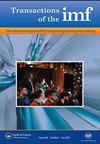镀锌合金的腐蚀行为和机械性能
IF 1.5
4区 材料科学
Q4 ELECTROCHEMISTRY
Transactions of The Institute of Metal Finishing
Pub Date : 1997-01-01
DOI:10.1080/00202967.1997.11871177
引用次数: 4
摘要
锌是最有效和最经济的防腐剂,特别是对钢基材料。通过在锌中加入少量(约1%)的过渡金属元素,如Co、Ni和Fe,可以提高锌的耐腐蚀性。采用碱性电解液和酸性电解液分别对含过渡金属1.5%的ZnFe和Zn-Co合金进行镀层处理。使用两种类型的电解质在钢基体上沉积镍含量高达14%的Zn-Ni合金。x射线研究表明,zn - fe合金的织构非常均匀,这导致在渗铬过程中形成了一层非常均匀且具有保护作用的铬酸盐层。在盐雾柜中进行的腐蚀试验表明,与传统的铬化纯锌层和其他低合金锌层相比,经过热处理的铬化锌-铁层具有优越的性能。这些结果得到了室外暴露试验和电化学研究的证实。随着锌合金有望取代镉合金在紧固件领域的应用,人们对锌合金的硬度和摩擦学等力学性能进行了研究。此外,还对沉积的高强度钢进行了氢脆试验。在电化学数据的基础上,建立了掺杂-空位相互作用模型,定性地解释了镀锌合金的腐蚀行为。本文章由计算机程序翻译,如有差异,请以英文原文为准。
Corrosion behaviour and mechanical properties of plated Zn-alloys
Zinc represents the most effective and economic corrosion protection especially for steel base materials. Improved corrosion resistance can be achieved by alloying zinc with small amounts (around 1%) of transition metal elements like Co, Ni and Fe. ZnFe and Zn-Co alloys containing up to 1.5% of the transition metal were plated using an alkaline and acidic electrolyte respectively. Zn-Ni alloys with Ni-contents up to 14% were deposited on steel substrates using both types of electrolytes. The very homogeneous texture of the Zn-Fe-alloys proved by X-ray investigations obviously leads to the formation of a very uniform and protecting chromate layer in the chromatizing process. Corrosion tests in the salt spray cabinet show a superior behaviour of chromated Zn-Fe-layers after heat treatment when compared to conventional chromated pure zinc layers and other low alloyed zinc layers. These results are confirmed by outdoor exposure tests and electrochemical investigations. As zinc-alloys are supposed to replace cadmium for fastener applications mechanical properties like hardness as well as tribological data are of importance and were investigated. Further, the hydrogen embrittlement of deposited high strength steel was also tested. On the basis of electro-chemical data a dopant-vacancy interaction model is presented for a qualitative explanation of the corrosion behaviour of plated zinc-alloys.
求助全文
通过发布文献求助,成功后即可免费获取论文全文。
去求助
来源期刊

Transactions of The Institute of Metal Finishing
工程技术-材料科学:膜
CiteScore
3.40
自引率
10.50%
发文量
62
审稿时长
3 months
期刊介绍:
Transactions of the Institute of Metal Finishing provides international peer-reviewed coverage of all aspects of surface finishing and surface engineering, from fundamental research to in-service applications. The coverage is principally concerned with the application of surface engineering and coating technologies to enhance the properties of engineering components and assemblies. These techniques include electroplating and electroless plating and their pre- and post-treatments, thus embracing all cleaning pickling and chemical conversion processes, and also complementary processes such as anodising. Increasingly, other processes are becoming important particularly regarding surface profile, texture, opacity, contact integrity, etc.
 求助内容:
求助内容: 应助结果提醒方式:
应助结果提醒方式:


